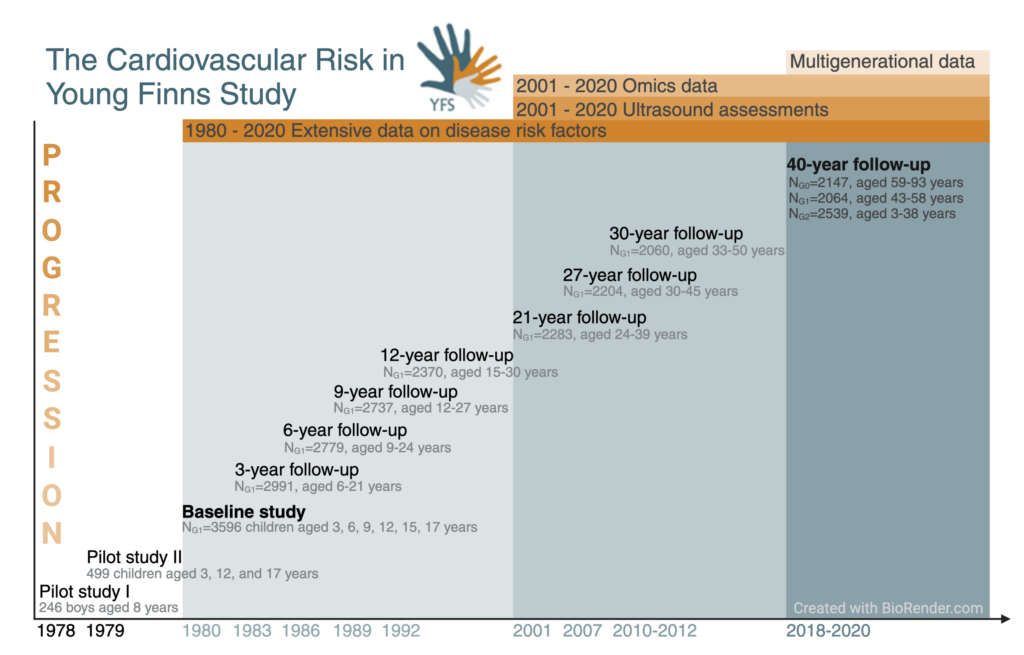Study Design
Background
Cardiovascular diseases are the most important causes of mortality and morbidity in developed countries. Although myocardial infarction and stroke usually occur in middle and late age, it has been recognized for a long time that the atherogenic process begins already in childhood.
Therefore, a program was launched in Finland in the late 1970’s to study cardiovascular risk in the youth. The multi-centre study, called The Cardiovascular Risk in Young Finns, was designed to study the risk factors and precursors of cardiovascular diseases and their determinants in children and adolescents. Two pilot studies were carried out in 1978 and 1979, and the first cross-sectional study in 1980. Thereafter, this cohort has been followed-up several times, and the latest field study was conducted in 2018-2020.
Study Cohort
The first cross-sectional study was conducted in 1980. A total of 4,320 boys and girls, who were randomly selected from the national register, and represented 6 age cohorts (aged 3, 6, 9, 12, 15 and 18 years) were invited to participate. Of the invited subjects, 3,596 (83.2% of those invited) participated the study baseline. After that, several follow-up studies have been conducted. The participation rates in the follow-up studies have varied between 60 and 80%.
In the latest follow-up in 2018-2020 the cohort was expanded to cover three generations including the original YFS participants, their parents and biological children. A total of 7,341 participants, aged 3-92 years, attended the three-generational field study, including 2127 original YFS participants, 2452 parents and 2762 biological children.
Methods
Examinations have included comprehensive data collection using questionnaires, physical measurements and blood tests. Primary study variables have been serum lipoproteins, insulin, inflammation markers, homocysteine, obesity indices, blood pressure, life-style factors, smoking status, alcohol use, general health status, diet, physical activity, psychological factors and socio-economic status.
In addition to the vast risk factor measurements, the follow-up studies in 2001, 2007, 2011 and 2018-2020 have included non-invasive ultrasound measurements of arterial function and structure, which are indicative of subclinical atherosclerosis. The protocol for ultrasound studies included measurements of carotid artery intima-media thickness and elasticity and the assessment of brachial artery flow-mediated dilatation (endothelial function). These markers of early atherosclerosis have been shown to correlate with cardiovascular risk factors, and they predict cardiovascular mortality and morbidity. Therefore, by using these non-invasive measures, it is possible to detect early changes of atherosclerosis long before the clinical manifestations of cardiovascular disease appear. Echocardiographic examination and retinal photography were performed in the 2010-2012 follow-up study. Additionally, liver ultrasound and cognitive function tests were introduced in the 2010-2012 follow-up study and repeated in the 2018-2020 follow-up.
Objectives
○ Study the influence of childhood risk factor profile on early atherosclerotic vascular changes and their progression in young adults.
○ Study the influence of life-style and life-style changes (diet, physical activity, smoking, alcohol use) on early atherosclerotic vascular changes in young adults.
○ Study the influence of behavioral and psychological factors on early atherosclerotic vascular changes in young adults.
○ Study the influence of new risk factors, such as oxidized LDL, homocysteine, C-reactive protein, asymmetric dimethylarginine, leptin, adhesion molecules, chlamydia infection on early atherosclerotic vascular changes in young adults.
○ Study the influence of gene variation and gene-environment interactions on early atherosclerotic vascular changes in young adults.
○ Study risk factor levels and their regional differences
○ Study determinants of risk factor levels and the mechanisms how risk factor levels change into adulthood levels
○ Study tracking phenomen and risk factor clustering
○ Collect background information for primary prevention

